- Home
- Medical news & Guidelines
- Anesthesiology
- Cardiology and CTVS
- Critical Care
- Dentistry
- Dermatology
- Diabetes and Endocrinology
- ENT
- Gastroenterology
- Medicine
- Nephrology
- Neurology
- Obstretics-Gynaecology
- Oncology
- Ophthalmology
- Orthopaedics
- Pediatrics-Neonatology
- Psychiatry
- Pulmonology
- Radiology
- Surgery
- Urology
- Laboratory Medicine
- Diet
- Nursing
- Paramedical
- Physiotherapy
- Health news
- Fact Check
- Bone Health Fact Check
- Brain Health Fact Check
- Cancer Related Fact Check
- Child Care Fact Check
- Dental and oral health fact check
- Diabetes and metabolic health fact check
- Diet and Nutrition Fact Check
- Eye and ENT Care Fact Check
- Fitness fact check
- Gut health fact check
- Heart health fact check
- Kidney health fact check
- Medical education fact check
- Men's health fact check
- Respiratory fact check
- Skin and hair care fact check
- Vaccine and Immunization fact check
- Women's health fact check
- AYUSH
- State News
- Andaman and Nicobar Islands
- Andhra Pradesh
- Arunachal Pradesh
- Assam
- Bihar
- Chandigarh
- Chattisgarh
- Dadra and Nagar Haveli
- Daman and Diu
- Delhi
- Goa
- Gujarat
- Haryana
- Himachal Pradesh
- Jammu & Kashmir
- Jharkhand
- Karnataka
- Kerala
- Ladakh
- Lakshadweep
- Madhya Pradesh
- Maharashtra
- Manipur
- Meghalaya
- Mizoram
- Nagaland
- Odisha
- Puducherry
- Punjab
- Rajasthan
- Sikkim
- Tamil Nadu
- Telangana
- Tripura
- Uttar Pradesh
- Uttrakhand
- West Bengal
- Medical Education
- Industry
Tonsil size, a factor in pediatric sleep apnea triage algorithm, Study says

Diagnosis and treatment of obstructive sleep apnea (OSA) in children is often delayed due to the high prevalence and limited physician and sleep testing resources.
As a result, children may be referred to multiple specialties, such as pediatric sleep medicine and pediatric otolaryngology, resulting in long waitlists.
Hence, a recent study published by D. S. Heath et al in the Journal of Otolaryngology - Head & Neck Surgery have found out that tonsil size was the strongest predictor of adenoidectomy (AT), while oximetry helped stratify individual risk for AT and this can help in triaging the pediatric patients.
The authors further highlighted that children with 2+ tonsil sizes should be triaged to otolaryngology, while the remainder should be referred to a pediatric sleep specialist.
The study used the data from the pediatric OSA clinic to identify predictors of tonsillectomy and/or adenoidectomy (AT). Before being seen in the clinic, parents completed the Pediatric Sleep Questionnaire (PSQ) and screening questionnaires for restless leg syndrome (RLS), nasal rhinitis, and gastroesophageal reflux disease (GERD).
Tonsil size data were obtained from patient charts and graded using the Brodsky-five grade scale. Children completed an overnight oximetry study before being seen in the clinic, and a McGill oximetry score (MOS) was assigned based on the number and depth of oxygen desaturations.
Logistic regression, controlling for otolaryngology physician, was used to identify significant predictors of AT. Three triage algorithms were subsequently generated based on the univariate and multivariate results to predict AT.
From the OSA cohort, there were 469 eligible children, 47% female with a mean age = 8.19 years, out of which 89% of children reported snoring. Significant predictors of AT in univariate analysis included tonsil size and four PSQ questions, (1) struggles to breathe at night, (2) apneas, (3) daytime mouth breathing, and (4) AM dry mouth.
The first triage algorithm, only using the four PSQ questions, had an odds ratio (OR) of 4.02 for predicting AT (sensitivity = 0.28, specificity = 0.91).
Using only tonsil size, the second algorithm had an OR to predict AT of 9.11 (sensitivity = 0.72, specificity = 0.78).
The third algorithm, where MOS was used to stratify risk for AT among those children with 2+ tonsils, had the same OR, sensitivity, and specificity as the tonsil-only algorithm.
As a result, it was concluded that tonsil size was the strongest predictor of AT, while oximetry helped stratify individual risk for AT. The researchers recommend that referral letters for snoring children include graded tonsil size to aid in the triage based on the findings. Furthermore, children with 2+ tonsil sizes should be triaged to otolaryngology, while the remainder should be referred to a pediatric sleep specialist.
Dr. Nandita Mohan is a practicing pediatric dentist with more than 5 years of clinical work experience. Along with this, she is equally interested in keeping herself up to date about the latest developments in the field of medicine and dentistry which is the driving force for her to be in association with Medical Dialogues. She also has her name attached with many publications; both national and international. She has pursued her BDS from Rajiv Gandhi University of Health Sciences, Bangalore and later went to enter her dream specialty (MDS) in the Department of Pedodontics and Preventive Dentistry from Pt. B.D. Sharma University of Health Sciences. Through all the years of experience, her core interest in learning something new has never stopped. She can be contacted at editorial@medicaldialogues.in. Contact no. 011-43720751
Dr Kamal Kant Kohli-MBBS, DTCD- a chest specialist with more than 30 years of practice and a flair for writing clinical articles, Dr Kamal Kant Kohli joined Medical Dialogues as a Chief Editor of Medical News. Besides writing articles, as an editor, he proofreads and verifies all the medical content published on Medical Dialogues including those coming from journals, studies,medical conferences,guidelines etc. Email: drkohli@medicaldialogues.in. Contact no. 011-43720751


